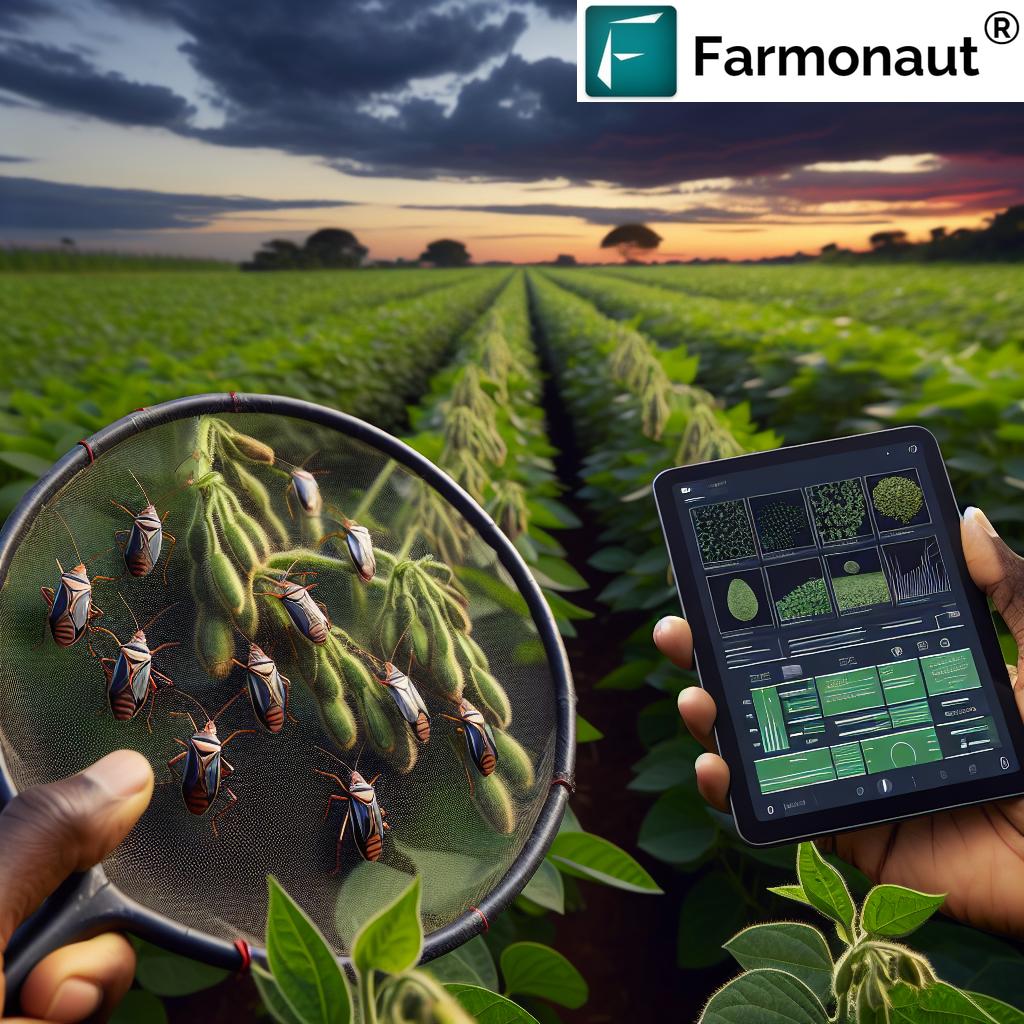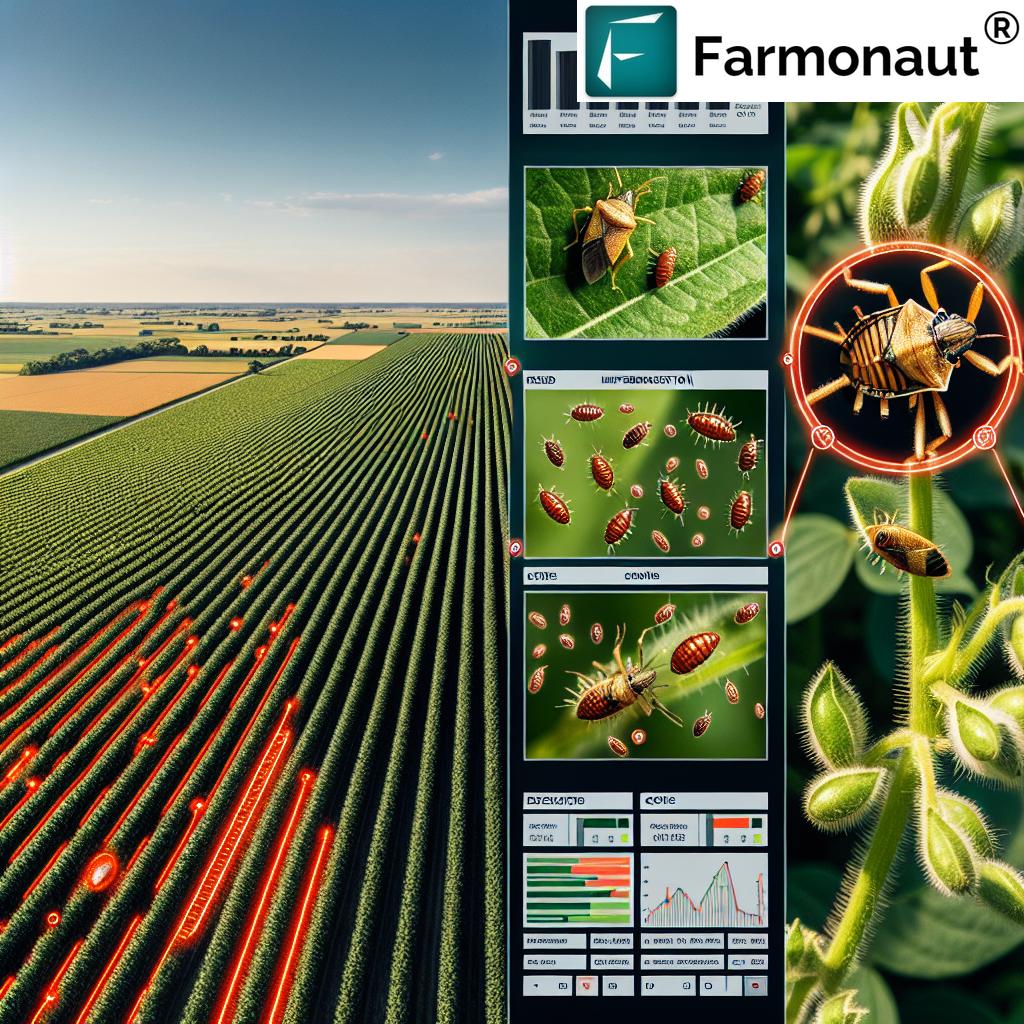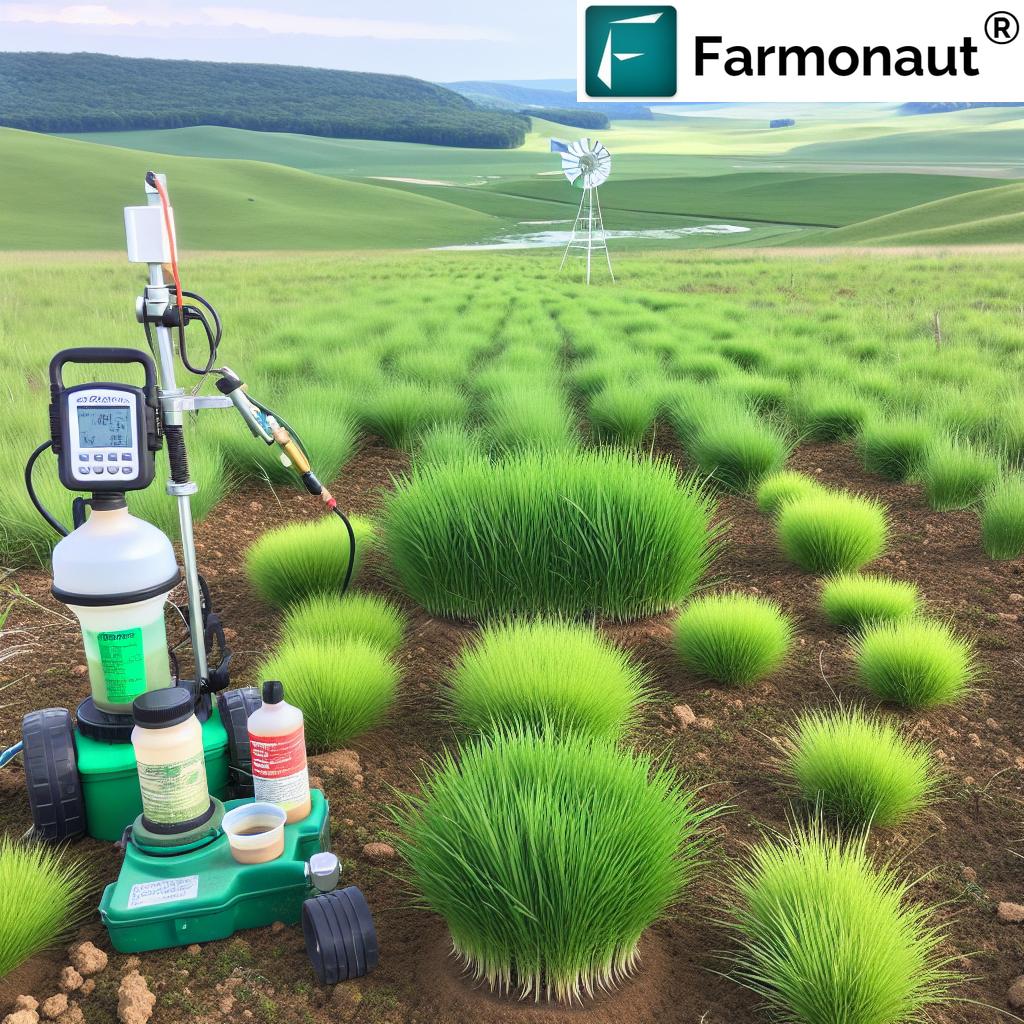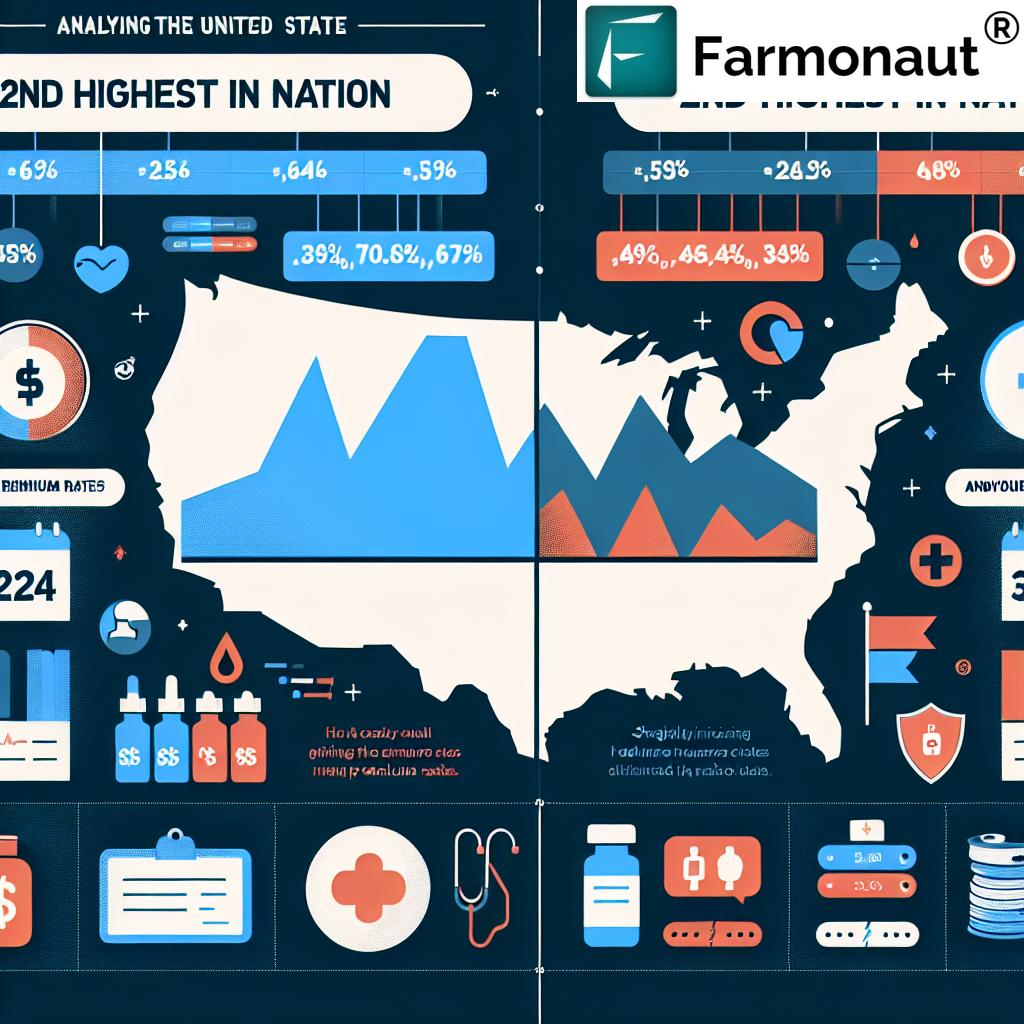Mastering Stink Bug Scouting: Essential Tips for Iowa Soybean Farmers to Boost Yield Protection

“Effective stink bug scouting in soybeans requires monitoring from bloom through maturity, covering approximately 6-8 weeks of the growing season.”
Welcome, Iowa soybean farmers! In this comprehensive guide, we’ll dive deep into the world of stink bug scouting, arming you with essential tips to protect your yields and maximize your crop’s potential. As we navigate the challenges of soybean pest management, we’ll explore cutting-edge precision agriculture techniques and digital agriculture solutions that can revolutionize your approach to crop protection.
At Farmonaut, we understand the critical importance of safeguarding your soybean yields against these elusive pests. Our mission is to empower farmers like you with the knowledge and tools necessary to implement effective integrated pest management in agriculture. By combining traditional scouting methods with advanced technology, we can help you stay one step ahead of potential infestations and ensure the health of your crops throughout the growing season.
Understanding the Stink Bug Threat in Iowa Soybeans
Before we delve into scouting techniques, let’s briefly examine why stink bugs pose such a significant threat to soybean crops in Iowa:
- Yield Reduction: Stink bugs can cause substantial damage to soybean pods, leading to reduced yields and quality.
- Difficult Detection: These pests are often challenging to spot, making regular and thorough scouting crucial.
- Economic Impact: If left unchecked, stink bug infestations can result in significant economic losses for farmers.
By mastering stink bug scouting tips and implementing a robust pest management strategy, you can protect your investment and maintain high yields.
The Importance of Timely Scouting
Effective scouting is the cornerstone of successful pest management. Here’s why timing is critical:
- Early Detection: Regular scouting allows for early identification of stink bug populations before they reach damaging levels.
- Targeted Control: Timely detection enables more precise and effective control measures, reducing unnecessary pesticide use.
- Cost-Effective Management: By addressing pest issues early, you can minimize crop damage and potentially save on treatment costs.
To enhance your scouting efforts, consider integrating Farmonaut’s satellite-based crop monitoring tools into your routine. Our platform provides real-time insights into crop health, helping you identify potential problem areas quickly and efficiently.
Essential Scouting Tools and Techniques
To effectively scout for stink bugs in your soybean fields, you’ll need the right tools and techniques. Let’s explore some essential items and methods:
1. Sweep Nets
Sweep nets are invaluable tools for capturing and assessing stink bug populations in soybean fields. Here’s how to use them effectively:
- Choose the right net: Use a heavy-duty, 15-inch diameter sweep net for best results.
- Proper technique: Sweep in a 180-degree arc, taking about 25 sweeps per sample site.
- Sample multiple locations: Take samples from various parts of the field to get an accurate representation of pest populations.
2. Drop Cloths
Drop cloths, also known as beat sheets, are excellent for detecting stink bugs in narrow-row soybeans. Here’s how to use them:
- Select an appropriate cloth: Use a light-colored cloth measuring about 3 feet by 3 feet.
- Placement: Carefully place the cloth between two rows of soybeans.
- Sampling technique: Vigorously shake the plants over the cloth to dislodge any insects.
- Count and identify: Quickly count the number of stink bugs that fall onto the cloth.
3. Visual Inspection
While less efficient than sweep nets or drop cloths, visual inspection can still be valuable, especially in areas where other methods are challenging to implement:
- Examine plants: Carefully inspect leaves, stems, and pods for stink bugs and egg masses.
- Check multiple plants: Inspect at least 20 plants per location to get a representative sample.
- Look for damage: Be on the lookout for feeding damage on pods and seeds.
“Proper use of sweep nets can capture up to 75% more stink bugs compared to visual inspection alone in soybean fields.”
By combining these scouting tools and techniques with Farmonaut’s advanced crop monitoring solutions, you can significantly enhance your ability to detect and manage stink bug populations in your soybean fields.
Implementing a Comprehensive Scouting Strategy
Now that we’ve covered the essential tools, let’s dive into a comprehensive scouting strategy that will help you protect your soybean yields effectively:
1. Start Early and Scout Regularly
Begin scouting for stink bugs as soon as soybeans start flowering (R1 stage) and continue through pod fill (R6 stage). Regular scouting is crucial for early detection and timely intervention. We recommend the following schedule:
- Early season (R1-R3): Scout once a week
- Mid to late season (R4-R6): Increase frequency to twice a week
- Late season (R7-R8): Continue scouting weekly until harvest
2. Use a Systematic Sampling Pattern
To ensure comprehensive coverage of your fields, use a systematic sampling pattern:
- W-pattern: Walk in a W-shaped pattern across the field, taking samples at regular intervals.
- Edge sampling: Pay extra attention to field edges, as stink bugs often invade from surrounding vegetation.
- Multiple locations: Sample at least 5-10 locations per field, depending on field size.
3. Keep Detailed Records
Maintain accurate records of your scouting activities to track pest populations over time:
- Date and location of each sample
- Number and species of stink bugs found
- Crop growth stage
- Weather conditions
- Any observed damage or other notable observations
Farmonaut’s digital agriculture solutions can help streamline this record-keeping process, allowing you to easily track and analyze pest data over time.
Understanding Treatment Thresholds
Knowing when to take action is crucial for effective pest management. Treatment thresholds for stink bugs in soybeans can vary depending on the crop stage and intended use of the crop. Here are some general guidelines:
- For grain soybeans:
- R1-R5 stages: 10 or more stink bugs per 25 sweeps
- R6-R7 stages: 20 or more stink bugs per 25 sweeps
- For seed production:
- R1-R7 stages: 5 or more stink bugs per 25 sweeps
Remember, these are general guidelines. Always consult with your local extension office or crop advisor for region-specific recommendations.
Leveraging Technology for Enhanced Scouting
While traditional scouting methods remain invaluable, integrating technology can significantly improve your pest management efforts. Farmonaut’s precision agriculture techniques offer several advantages:
- Satellite imagery: Our platform uses multispectral satellite images to monitor crop health, helping you identify potential problem areas that may require closer inspection.
- AI-powered insights: Our Jeevn AI advisory system analyzes satellite data and other inputs to provide personalized recommendations for pest management.
- Mobile app integration: Access real-time crop data and scouting tools right from your smartphone, allowing for more efficient field visits and data collection.
By combining these advanced tools with your on-the-ground expertise, you can create a powerful, data-driven approach to stink bug management in your soybean fields.
Implementing Integrated Pest Management (IPM) Strategies
Effective stink bug control goes beyond scouting and chemical treatments. Implementing a comprehensive IPM approach can help you manage pest populations more sustainably and cost-effectively. Consider the following strategies:
1. Cultural Controls
- Crop rotation: Rotate soybeans with non-host crops to disrupt pest life cycles.
- Planting dates: Adjust planting dates to avoid peak stink bug activity periods.
- Field borders: Maintain clean field borders to reduce overwintering sites for stink bugs.
2. Biological Controls
- Beneficial insects: Encourage natural predators like parasitic wasps and predatory insects.
- Cover crops: Use cover crops to support beneficial insect populations.
3. Chemical Controls
- Selective insecticides: When necessary, use targeted insecticides that minimize impact on beneficial insects.
- Timing: Apply treatments based on scouting data and economic thresholds.
- Rotation: Rotate insecticide classes to prevent resistance development.
By integrating these IPM strategies with regular scouting and Farmonaut’s advanced crop monitoring tools, you can create a robust, sustainable approach to stink bug management in your soybean fields.

Stink Bug Scouting Guide for Iowa Soybean Farmers
| Growth Stage | Scouting Method | Treatment Threshold | Key Observations |
|---|---|---|---|
| Early Vegetative (VE-V3) | Visual inspection | N/A – Monitor only | Look for early-season colonizers on seedlings |
| Late Vegetative to Early Reproductive (V4-R2) | Sweep net | 10 stink bugs per 25 sweeps | Check for adults and nymphs on stems and leaves |
| Pod Development (R3-R4) | Sweep net and drop cloth | 10 stink bugs per 25 sweeps | Inspect for feeding damage on developing pods |
| Seed Fill (R5-R6) | Sweep net and drop cloth | 10 stink bugs per 25 sweeps | Look for distorted or aborted seeds |
| Beginning Maturity (R7) | Visual inspection | 20 stink bugs per 25 sweeps | Check for late-season damage to maturing pods |
| Full Maturity (R8) | Visual inspection | N/A – Evaluate damage only | Assess overall yield impact and plan for next season |
Maximizing the Benefits of Digital Agriculture Solutions
As we continue to explore ways to enhance your stink bug scouting efforts, it’s crucial to understand how digital agriculture solutions can complement and augment your traditional methods. Farmonaut’s platform offers a range of tools that can significantly improve your pest management strategies:
1. Satellite-Based Crop Health Monitoring
Our advanced satellite imagery provides valuable insights into your crop’s health and potential stress areas:
- NDVI (Normalized Difference Vegetation Index) maps: Identify areas of your field that may be experiencing stress, which could be indicative of pest pressure.
- Temporal analysis: Track changes in crop health over time, helping you spot emerging issues before they become severe.
- Zone management: Create management zones based on crop health data for more targeted scouting and treatment applications.
2. Weather Data Integration
Understanding weather patterns is crucial for effective pest management. Our platform provides:
- Local weather forecasts: Plan your scouting activities around optimal weather conditions.
- Historical weather data: Analyze past weather patterns to predict potential pest outbreaks.
- Growing degree day calculations: Track crop development stages to better time your scouting efforts.
3. Mobile Scouting Apps
Our mobile applications streamline the scouting process and data collection:
- GPS-tagged notes: Record pest observations with precise location data.
- Photo documentation: Capture and store images of pests and damage for future reference.
- Real-time data sync: Share scouting data instantly with your team or advisors for quick decision-making.
By integrating these digital tools into your scouting routine, you can create a more efficient, data-driven approach to stink bug management in your soybean fields.
Best Practices for Sustainable Stink Bug Management
As we strive for long-term success in soybean production, it’s essential to adopt sustainable farming practices that balance effective pest control with environmental stewardship. Here are some best practices to consider:
1. Promote Biodiversity
- Encourage beneficial insects: Plant flowering strips or hedgerows to attract natural predators of stink bugs.
- Minimize broad-spectrum insecticide use: Opt for targeted treatments to preserve beneficial insect populations.
- Implement crop rotations: Diversify your crop rotations to disrupt pest life cycles and improve overall soil health.
2. Optimize Nutrient Management
Healthy plants are better equipped to withstand pest pressure. Use Farmonaut’s precision agriculture techniques to:
- Conduct regular soil tests: Ensure your soybeans have access to balanced nutrients throughout the growing season.
- Implement variable-rate fertilization: Apply nutrients based on zone-specific needs to promote uniform crop development.
- Monitor crop nutrient status: Use our satellite-based vegetation indices to identify potential nutrient deficiencies early.
3. Embrace Precision Application Technologies
When chemical controls are necessary, use precision application methods to minimize environmental impact:
- Variable-rate spraying: Apply insecticides only where needed based on scouting data and crop health maps.
- Drift reduction technologies: Utilize equipment and techniques that minimize off-target movement of pesticides.
- Timing optimization: Use Farmonaut’s weather data to plan applications during optimal conditions for efficacy and safety.
Leveraging Data for Continuous Improvement
One of the key advantages of integrating digital agriculture solutions into your stink bug management strategy is the wealth of data you’ll accumulate over time. Here’s how to make the most of this valuable information:
1. Historical Analysis
- Track pest pressure trends: Analyze year-over-year data to identify patterns in stink bug populations and damage.
- Evaluate management strategies: Compare the effectiveness of different control methods across seasons.
- Refine economic thresholds: Use historical yield data to fine-tune treatment decisions for your specific operation.
2. Predictive Modeling
Farmonaut’s AI-powered advisory system can help you anticipate potential pest outbreaks:
- Weather-based predictions: Identify conditions that are favorable for stink bug population growth.
- Risk mapping: Generate field-specific risk maps based on historical data and current conditions.
- Early warning alerts: Receive notifications when conditions suggest increased pest activity.
3. Collaborative Learning
Share insights and learn from other farmers in your area:
- Anonymized data sharing: Contribute to and benefit from regional pest pressure maps.
- Best practice exchange: Participate in online forums or local grower groups to share successful management strategies.
- Research partnerships: Collaborate with universities or extension services to contribute to ongoing pest management studies.
Preparing for Future Challenges
As we look to the future of soybean production in Iowa, it’s important to stay ahead of potential challenges. Here are some key areas to focus on:
1. Climate Change Adaptation
- Monitor shifting pest patterns: Use Farmonaut’s long-term data analysis to track changes in stink bug behavior and distribution.
- Explore climate-resilient varieties: Stay informed about soybean varieties that may offer better resistance to pests under changing conditions.
- Adjust management practices: Be prepared to modify your scouting and treatment strategies as pest pressures evolve.
2. Emerging Technologies
Stay informed about new tools that can enhance your pest management efforts:
- Drone-based scouting: Explore the potential of UAV technology for more efficient field monitoring.
- IoT sensors: Consider integrating in-field sensors to provide real-time data on pest activity and environmental conditions.
- Advanced biologicals: Keep an eye on developments in biopesticides and other alternative control methods.
3. Regulatory Awareness
- Stay informed: Keep up-to-date with changing regulations regarding pesticide use and environmental protection.
- Documentation: Use Farmonaut’s digital tools to maintain detailed records of your pest management activities for compliance purposes.
- Sustainability certification: Explore opportunities to certify your sustainable farming practices, potentially opening new market opportunities.
By staying proactive and embracing both traditional wisdom and cutting-edge technology, you can ensure that your soybean operation remains resilient and productive in the face of evolving pest challenges.
Conclusion: Empowering Iowa Soybean Farmers for Success
As we conclude our comprehensive guide to mastering stink bug scouting in Iowa soybean fields, let’s recap the key takeaways:
- Regular, systematic scouting is crucial for early detection and effective management of stink bug populations.
- Integrating traditional scouting methods with advanced digital agriculture solutions can significantly enhance your pest management efforts.
- Implementing a holistic IPM approach, including cultural, biological, and chemical controls, leads to more sustainable and cost-effective pest management.
- Leveraging data and technology allows for continuous improvement and adaptation to emerging challenges in soybean production.
By embracing these strategies and utilizing the powerful tools provided by Farmonaut, you’re well-equipped to protect your soybean yields and ensure the long-term success of your farming operation. Remember, effective pest management is an ongoing process of learning, adaptation, and innovation.
We encourage you to explore Farmonaut’s suite of digital agriculture solutions to take your stink bug scouting and overall crop management to the next level. Together, we can build a more resilient and productive future for Iowa soybean farming.
FAQ Section
Q: How often should I scout for stink bugs in my soybean fields?
A: Begin scouting weekly from the early flowering stage (R1) and increase to twice weekly during pod development and seed fill stages (R3-R6).
Q: What’s the best time of day to scout for stink bugs?
A: Early morning or late evening when temperatures are cooler, and stink bugs are less active, making them easier to spot.
Q: Can Farmonaut’s satellite imagery detect stink bug infestations?
A: While satellite imagery can’t directly detect stink bugs, it can identify areas of crop stress that may indicate pest pressure, guiding your on-ground scouting efforts.
Q: How can I differentiate between beneficial and harmful stink bug species?
A: Consult local extension resources for identification guides. Generally, predatory stink bugs have a more robust build and spined shoulders compared to plant-feeding species.
Q: Are there any natural predators of stink bugs I should encourage in my fields?
A: Yes, several beneficial insects prey on stink bugs, including parasitic wasps, predatory stink bugs, and some spider species. Maintaining diverse field margins can help support these natural enemies.
Ready to take your soybean pest management to the next level? Explore Farmonaut’s advanced crop monitoring solutions:
Web App: Access Farmonaut’s Web Platform
Mobile Apps:
For Developers: Integrate our powerful API into your own applications. Explore Farmonaut’s API and check out our API Developer Docs.
Together, we can revolutionize soybean pest management and ensure a prosperous future for Iowa’s agricultural community.
















